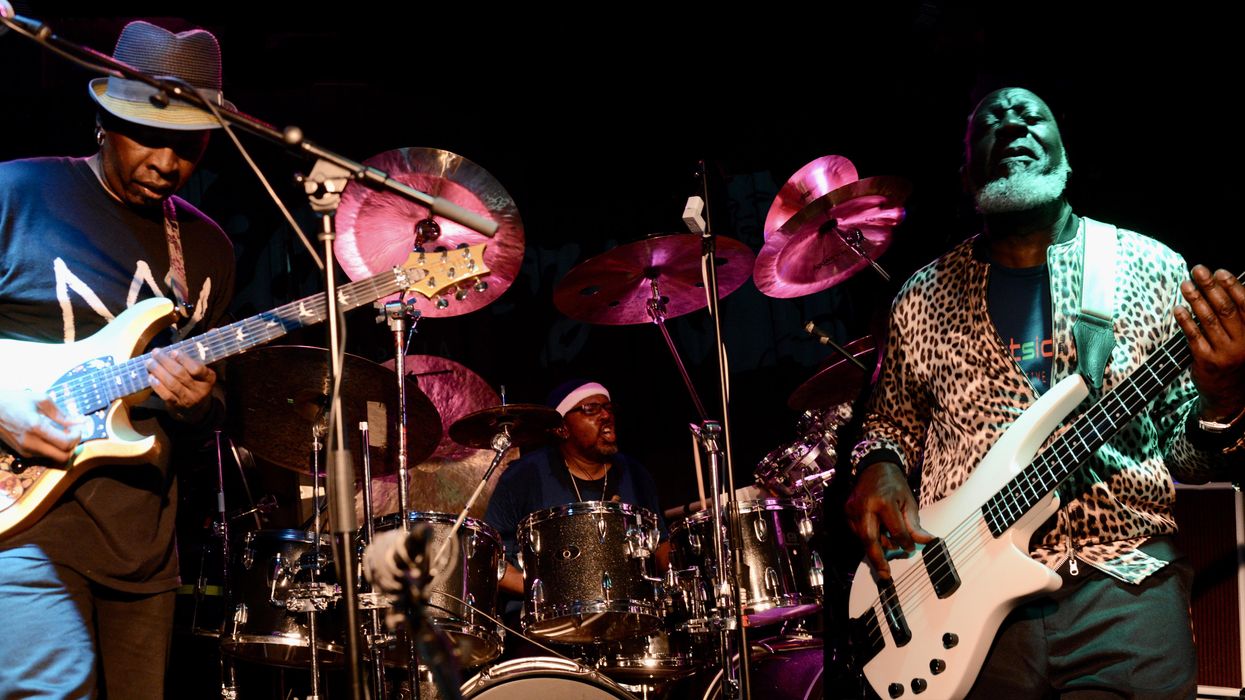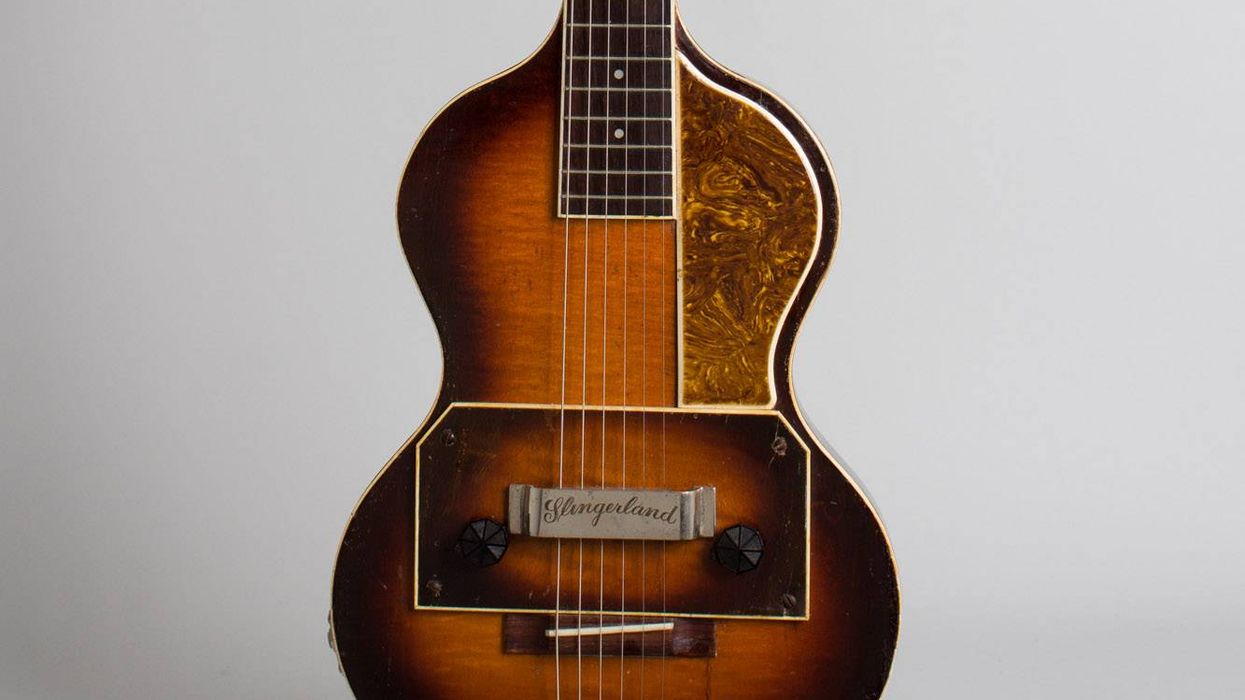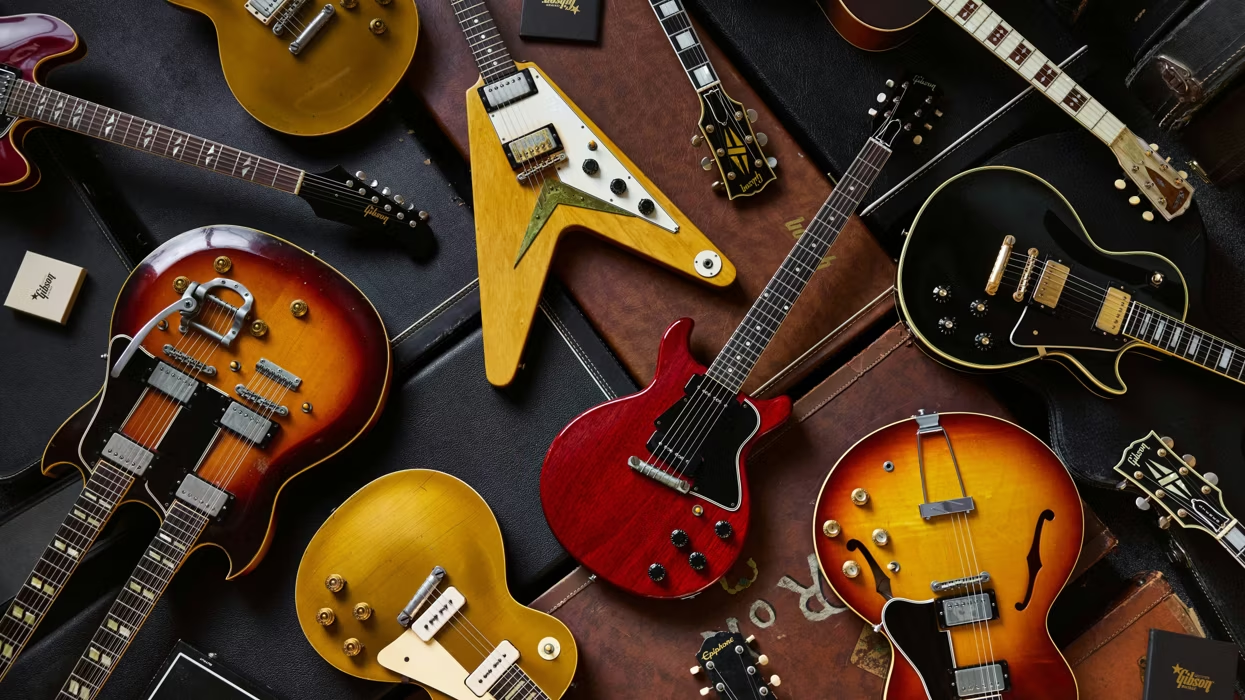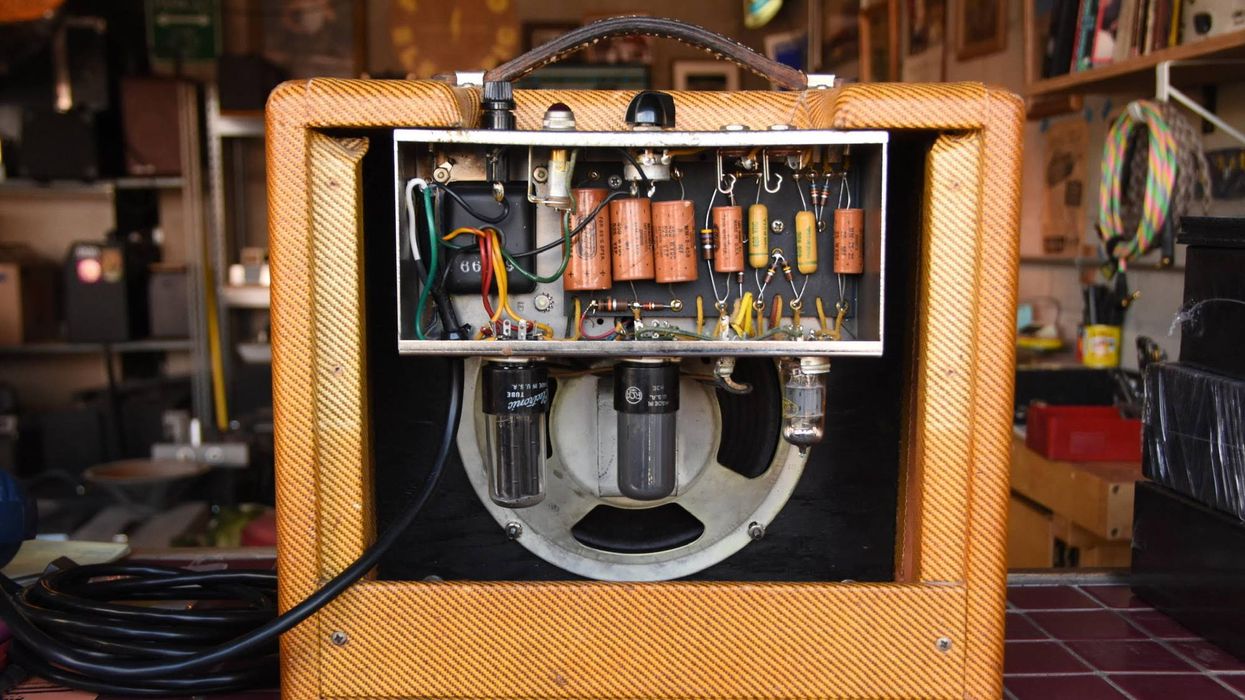It’s hard not to bedazzled by the Aristocrats in action, as guitar god Guthrie Govan unleashes multi-octave, tapped arpeggios at warp speed atop head-spinning, ultra-precise, odd-meter grooves flawlessly executed by drummer Marco Minnemann and bassist Bryan Beller. The three superhuman virtuosos came together by accident at Winter NAMM 2011, when Govan filled in on a gig for Greg Howe. From the first note, the chemistry was obvious, and the Aristocrats were born. Outside of the Aristocrats, the members perform as sidemen to an A-list of musician’s musicians: Govan and Minnemann are part of Steven Wilson’s recording and touring band, and Beller is the bassist of choice for guitar icons like Steve Vai, Joe Satriani, Mike Keneally, and Dweezil Zappa.
Time is always in short supply for these busy musicians, so they adopted a new strategy to get their music in shape before recording Tres Caballeros: They arranged a weeklong residency at Alvas, a fusion club in San Pedro, California, and put each song through its paces. “We were able to rehearse the material for three days and then do four days of solid gigging,” says Govan. “We were relatively gig-fit by the time we got into the studio, and it really made a difference, I have to say.” Tres Caballeros was recorded at the legendary Sunset Sound Studios, where seminal rock guitar masterpieces by the likes of Van Halen and Led Zeppelin were born. While the group’s past efforts exploited the sonic possibilities of the trio format, Tres Caballeros aims for a more expansive sound with liberal use of overdubs.
Premier Guitar caught up with Govan to discuss Tres Caballeros, a surprising new project he’s working on (it has nothing to do with sweep picking or legato licks), and the stripped-down rig he used to create the album’s otherworldly sounds.
Do you write differently for the Aristocrats than you would for a solo project?
We write specifically for each other. We’re pretty familiar with each other’s playing styles and abilities. We might write something that we wouldn’t for another band because we know a certain musician will handle a part in a certain way. There’s an element of trust in the writing process once you know what your bandmates can do. The other thing is just being conscious that you’re writing for a trio.
A big part of what this band does is take the material out on the road and let the songs grow over the course of a year or so of touring. We write stuff that we can envisage working well in a trio context onstage. My solo stuff was never like that. On something like Erotic Cakes, I wasn’t shy about throwing overdubs at the tracks until it sounded complete.
Unlike previous releases, Tres Caballeros has many overdubbed layers.
Well, we went into the studio this time without any qualms or reservations about adding overdubs. We thought to ourselves, “Screw it. We’ve done the raw trio album. Let’s try to make something that sounds more polished.” And then when we take the songs out live, people can hear another approach.
So live, you’d leave some of the layered parts out? Or would you use a looper?
No, we don’t really do the looper thing. The main point with these songs is that we did road test them as a trio, so we already knew in our heads what the arrangements would be when we took it out live. Anything you hear as an overdub is just a decoration. In theory, if you take all the overdubs away, it’s still recognizably that song.
How much of what we hear on the album is worked out? For example, in “Pig’s Day Off” there’s a part where it sounds like you guys are just going nuts. Is that improvised, or would you play this section the same at every show?
It would never be the same. We try to write with the strengths of the band in mind, so every tune has a certain amount of fairly orchestrated, fairly specific sections. But we also try to incorporate other sections where we can just go crazy and do our thing. We interact and try to surprise each other. So something like the middle section of “Pig’s Day Off,” where it all goes a bit bizarre, the chart would just be, “Let’s all just allow chaos to reign supreme for 16 bars, or 32 bars, or until one of us nods.” And then when the nod comes we go back into the arranged stuff. It’s nice to have both extremes.
Have there ever been any onstage mishaps?
That’s part of the fun of playing live music that has an improvised element baked into it. You almost want to get lost because that’s where the cool things happen. Inspiration will strike you differently if you’re seeking out unfamiliar territory. The thing that gives us some peace of mind there is that we’re trying to be a team. If one of us does a crazy, confusing fill, we’re not actually trying to mess up the other guys in the band. We’re there to catch each other if something goes go wrong.
The Aristocrats, from left to right: Marco Minnemann on drums, Bryan Beller on bass, and Guthrie Govan on guitar.
The Aristocrats’ music requires an extremely high level of musicianship beyond just physical chops. How do you suggest a fan go from, say, picking exercises to being able to handle such complex musical situations?
You might be asking the wrong person because I’m not a shredder who suddenly realized one day, “Oh, hang on—there’s music as well.” Music has always come first for me. Shred is such an ugly word, isn’t it? I play a lot of notes because I’m a skinny, twitchy, blinky, coffee-drinking person, and the music I hear in my head really does contain that many notes. So if people are looking up to me as some kind of shred figure, then to some extent I worry that they might be missing the point. The music has always come first, and then I inject some of my own personality into it. Maybe I play more notes per second than some other people do because that’s who I am.
On “ZZ Top” you play some chromatic fusion-sounding phrases. How do you suggest a rock shredder incorporate more adventurous note choices?
I would say listening to music is really the key. Before you try to introduce any new elements into your playing, it’s important that you have a feel for those elements and actually like them. I think things start to go wrong if a shred kid who listens to metal all the time decides that they’re going to start using jazz elements or chromatic elements because they read somewhere on the internet that that’s what you’re supposed to do. I think the main thing is to listen to music that incorporates these elements and develop an ear for them. That way, when you learn stuff about chromatic playing, you have more of a concept of where exactly you would apply these things.
Although Bryan wrote “Through the Flower,” your solo’s phrasing and melodic use of fifths remind me of Steve Vai’s playing.
That’s not really a solo part—Bryan wrote it. He didn’t do charts this time. He recorded it to an MP3, and all of that fifths stuff was there on the demo.
Considering Bryan’s long history with Vai, that makes perfect sense.
With that section, Bryan recorded a whole guitar part there, and we had a Skype conversation. I was asking him, “Bryan, how much of this is composed, and how much of this is filler? Because I can’t always tell which phrases I have to replicate because they’re part of the song, and which phrases are just you suggesting a fill or something in between.” So in the intro section, the actual fifths line is composed, and the stuff in between was like “insert fill here.” And then do the fifths again, then insert fill.
If I caught myself deliberately playing something because I wanted it to sound like Steve Vai, I would stop and say, “Let’s do something else.” Steve Vai is fantastic, but we already have one of him. I never really set out to rip off anyone else. In this case, yeah, I can hear how the stacked fifths might remind someone of Steve Vai. It reminds me equally of someone dropping a violin on the floor. It’s a popular interval.
Guthrie Govan's Gear
Guitars
Charvel Guthrie Govan signature model
Fender American Deluxe Stratocaster
Fender Custom Shop cedar-bodied Telecaster
Amps
Victory V100 head, Victory 4x12 cab with Celestion Vintage 30 speakers
Victory V50 head and cab
Victory V10 combo
Friedman BE100 old
5-watt Gibson combo
Effects
Xotic Wah
Dunlop Volume X
Boss volume pedal
Providence Anadime Chorus
Xotic Robotalk Envelope Filter
Xotic EP Booster
Boss Blues Driver Waza Craft
Strings and Picks
Rotosound Yellow (.010-.046, but with a .052 as the lowest string for dropped-D tuning, and the Strat had .011s throughout the Tres Cabelleros sessions)
Red Bear Guthrie Govan Big Jazzer (extra heavy)
What are you working on nowadays?
Right now I’m not playing a great deal of guitar.
I’m doing a lot of programming.
Programming music?
Yeah.
What kind of stuff?
I’ll let you know when it’s all finished. I’ll share a little observation with you: There’s a guy I went to school with called Tom Jenkinson. He now makes electronic music under the pseudonym Squarepusher. It’s really complex, bewildering, challenging electronic music somewhere between Weather Report and Aphex Twin, I guess. We get together every now and then, have a beer, and
just talk about our respective musical worlds. Something I always find fascinating about him is how quickly he can work. You listen to the results, and there’s some really in-depth, involved programming. I think to myself, “If I tried to program
something like that, it would take me a week just to program the first 10 seconds of it.” And by the time you’ve done that, you’ve forgotten what that initial seed of inspiration was. I would say to him, “How do you do this stuff so quickly?” You know, he’ll make a track in a day. He said it’s like any other instrument. It’s possible to attain virtuosity in programming as well. He’s thinking of the
computer or sequencer as another kind of instrument, and that stuck in my head. So in terms of writing music or being able to produce a demo of something while the idea is still hot, how quickly can you translate non-guitar ideas into a computer? So I guess I’ve been working on that kind of thing.
Let’s talk gear. I assume you primarily used your signature Charvel on Tres Caballeros.
Yes. Mostly the Charvel GG signature model, with guest appearances by two Fender instruments: an American Deluxe Stratocaster on “Kentucky Meat Shower” and “Texas Crazypants,” and a Custom Shop cedar-bodied Telecaster on “Stupid 7” and “Jack’s Back.”
How about amps?
I used a Victory V50 head and cab, Victory V10 combo, and a smattering of a Friedman BE100. At any given time, two of these three amps were running in parallel—the exact combination and blend varied from track to track. We also mixed in some signal from a very old 5-watt Gibson combo on “Smuggler’s Corridor.”
Govan plays his signature Charvel, which features custom Charvel MFB pickups in an HSH configuration with 5-way switching, master volume and tone, and a Charvel locking tremolo bridge. Photo by Kris Claerhout.
I assume your Aristocrats setup is smaller than the one you use for the Steven Wilson band.
That’s the main difference, really. By default, I go for the smallest rig that would work. Certainly if you’re playing instrumental music, consideration like how many flight cases you can take with you on the plane suddenly become a really big deal. If I tried to travel with the Aristocrats using all my Steven Wilson gear—a rack of four or five guitars and a pedalboard that weighs more than I do—suddenly the tour wouldn’t make any sense because we’d be losing money. A big part of my gear ethos is to keep it simple wherever possible.
What’s on your smaller board?
I haven’t quite decided yet. My typical, everyday touring board has a volume pedal, Xotic Wah, Providence chorus, maybe an Xotic envelope filter, Xotic EP Booster, a little tuner, and a TC Electronic mini delay and mini reverb in the effects loop. That’s pretty much it. Our tour for the new album will kick off in about a month, and there are a few strange sounds on the record that I might want to replicate with pedals that wouldn’t normally be on my board.
What sorts of pedals?
On this album some of the more memorable sounds came from an MXR Phase 99, which I borrowed from the good people at that company. It’s like two Phase 90s in one box. That’s all over “Pressure Relief” and “ZZ Top.” I don’t know if there was a subliminal Van Halen influence going on because we recorded in Sunset Sound where Fair Warning and Van Halen were recorded. Maybe some subliminal echo of Van Halen was there when we were recording. I felt the need to phase certain things.
a lot of programming.”
There’s also a freaky pedal called the Pigtronix Quantum, which is surprisingly small and portable—it’s smaller than a Boss pedal. It seemingly does the impossible in the sense that it’s actually replicating the DynaFlanger [MicMix], which was a big unwieldy thing that Zappa used in the ’70s—a Shut Up ’n Play Yer Guitar kind of thing. I used that for the solo in “The Kentucky Meat Shower” and the chordal overdubs in “Pig’s Day Off.” It’s not like a normal modulation pedal. With this one, the harder you hit it—the higher the dynamic level hitting the input—the more pronounced the effect. On the downbeat of the first main bar in the intro, the first big spraang where suddenly the chord sounds more expansive—that’s the Quantum on the left side and another on the right side. It sounds expansive but not obvious. It’s not the kind of modulation you hear all the time. I’m going to have to work out a way to get that onto the pedalboard.
The biggest pedal problem is “Stupid 7.” I might just go for something completely different from the record. What you hear in the solo in the middle section of “Stupid 7” is my new toy, the Electro-Harmonix HOG2. It’s awesome. It’s an amazing, synth-like, warm, analog kind of pedal, but it’s as big as the rest of my pedalboard put together. It’s hard to justify traveling with it just for that one moment in “Stupid 7.” We will see.
In the past, you’ve cited the volume pedal as the most important pedal in your arsenal.
I would say so, yeah.
YouTube It
With effortless transitions from prog-funk metal grooves to jazzy breakdowns, “Bad Asteroid” showcases the Aristocrats’ telepathic synchronicity and incredible virtuosity.
Do you use it to go from shades of clean and dirty or just to regulate level?
It’s on the go constantly. For the stuff we did on the album I was using amps with more than one channel, so I wasn’t completely old school. But whenever I have an overdrive channel, the volume pedal is a big part of how I control each note. I’m pretty much nailed to the thing all the way through the gig. That’s why every live photo of me looks the same. There’s always an uncomfortable posture with one leg sticking forward and bent. The luxury there is that you can set the amp to scream mode so it’s just wailing, howling, and feeding back uncontrollably, and then you can tame the level by backing the volume pedal down a little bit, so you know you always have that headroom there. Whenever you do want a note to scream obnoxiously, you just push the pedal all the way down, and it unleashes the full gain setting.
Is the volume pedal going straight into the amp or in the loop?
It’s straight in.
Some people consider you the world’s greatest guitarist.
Well, I couldn’t possibly comment on that. I’m not the world’s greatest guitar player, and I’m not trying to be. I’m just trying to be the best me I can be. I’m really trying to stay away from any of that competitive, Olympic league-table mentality. Given that this is music and it’s such an open-ended universe, you never really get there. And I’m sure if you talk to any committed, serious player, they would tell you something similar. I’m guessing if you ask Allan Holdsworth or Steve Vai or Eric Johnson or any of these people, “So, what’s it like, now that you’ve completely mastered the guitar?” They would say, “Well, I haven’t. I’m still working on it. I’m still learning. I’m still trying to get better.” I think you need that humility. You need that sense of perspective. That’s the thing that allows you to keep getting better and keep polishing your art form. When you start congratulating yourself, that’s where things go wrong and you become stale.
YouTube It
The Aristocrats played new tracks “Stupid 7” and “Jack’s Back” from their new album, Tres Caballeros, at the G4 Experience 2015 held June 28-July 2 in Cambria, California.














![Rig Rundown: Russian Circles’ Mike Sullivan [2025]](https://www.premierguitar.com/media-library/youtube.jpg?id=62303631&width=1245&height=700&quality=70&coordinates=0%2C0%2C0%2C0)












![Rig Rundown: AFI [2025]](https://www.premierguitar.com/media-library/youtube.jpg?id=62064741&width=1245&height=700&quality=70&coordinates=0%2C0%2C0%2C0)




















 Zach loves his Sovtek Mig 60 head, which he plays through a cab he built himself at a pipe-organ shop in Denver. Every glue joint is lined with thin leather for maximum air tightness, and it’s stocked with Celestion G12M Greenback speakers.
Zach loves his Sovtek Mig 60 head, which he plays through a cab he built himself at a pipe-organ shop in Denver. Every glue joint is lined with thin leather for maximum air tightness, and it’s stocked with Celestion G12M Greenback speakers.











